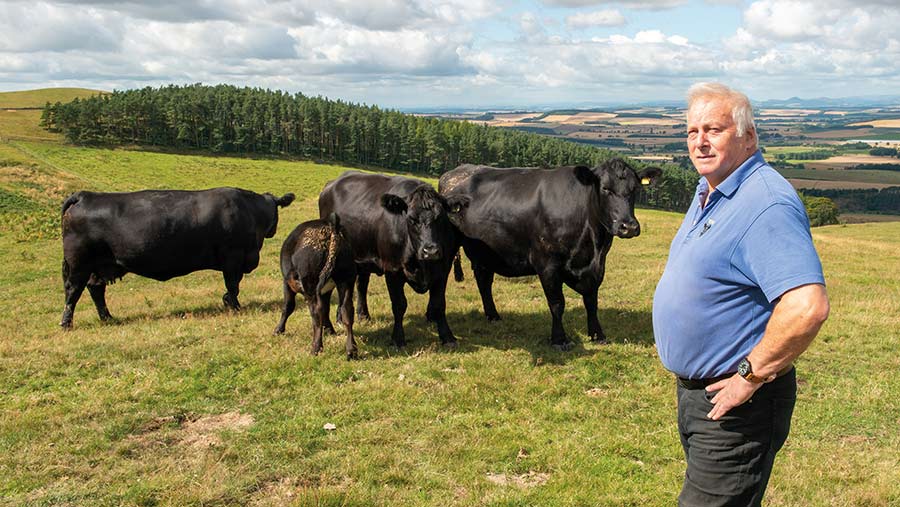Rival breeders’ collaboration sees Angus bull sales treble
 © Angus Findlay
© Angus Findlay A marketing partnership with a rival English breeder has enabled a Scottish Angus herd to treble its bull sales, rewarding the herd’s focus on cost control and type.
The Playfair-Hannays, trading as Playfair Farms, of Morebattle Tofts Farm, Kelso, sold around 12 bulls annually 10 years ago before teaming up with Paul Westaway of Melview Angus, Gloucestershire.
Playfair Farms sold close to 40 bulls last year; about half of these were sold through Melview.
See also: 3 beef systems and their earning potential compared
Farm Facts
Playfair Farms
- 420 suckler cows
- 289 Angus cows of which 150 are recorded pedigree Angus
- 75 Beef Shorthorns, 40 pedigree
- 1,400 North Country Cheviots
- About 1,780ha (4,400 acres)
- 202-323ha (500-800 acres) combinable
- 485ha (1,200 acres) improved grassland in rotation with cereals or root crops
- Rest is unimproved dry upland hill grazing
- 600mm (23 inches) rainfall
- Finished cattle sold to Stoddarts
Marketing partnership
The Playfair-Hannays benefit from collaborating with the 70-cow Melview Angus herd because Melview is within two hours’ drive of a million dairy cows.
With twice the number of pedigree cows as the Melview Angus herd, Playfair Farms brings scale to the partnership. Together they are striving to sell 85-90 bulls this year, mainly to Mr Westaway’s dairying clients, who want easy calving, short gestation, low-input sweeper bulls.
“The partnership is straightforward, and we get on well,” explains James Playfair-Hannay, who manages the cattle enterprise alongside family members and business partners Patrick, his father, wife Debbie and son Robert.
The Playfair-Hannays retain ownership of the bulls until payment. Melview Angus gets a fee covering marketing, commission, haulage and feeding from the sale price.
Bulls are typically only held at Melview for a few days or weeks. This year, Tofts sent 14 bulls down to Gloucestershire between 11 and 14 months of age and they were all delivered to customers within 10 days.
Commercial farm
Tofts Farm runs pedigree cattle as a commercial herd, which is helping attract bull buyers, explains Robert.
The family farm two farms rented from the family and a third under a contract farming agreement, each three miles apart.
The three farms (Morebattle Tofts, Clifton on Bowmont and Yetholm Mains) are similar, starting with arable on the gravelly valley floor at 91m, grassland leys on the hillsides and dry hills up to 518m for winter cattle.
The pedigree Angus herd is farmed at Morebattle Tofts. Beef Shorthorns are kept at Clifton on Bowmont, where animals that don’t make the Angus herd are run in a B herd and resultant Shorthorn crossbreds are taken to Yetholm Mains and farmed as commercial sucklers.
Each farm has loose housed sheds and a feeder wagon, straw bedder and forklift. Machinery cost is managed by buying good second-hand gear. Machinery is maintained on farm where possible. The Borders Machinery Ring is used to hire in specialist equipment.
Profit focus
The cows have been costed through a benchmarking group. This made the family scrutinise big cows weaning small calves or no calf at all.
It costs the farm roughly £750 to keep a 750kg cow. This covers variable and fixed costs as well as a £30,000 annual wage bill. Every cow that doesn’t produce a calf for sale can add up to £20 of extra cost on every cow on the farm.
“Depreciation and property maintenance are killers,” says James. “As a rule of thumb, roughly, a 600kg cow costs £600/year and an 800kg cow costs £800/year due to higher maintenance requirements.”
James says this commercial realism helps them market bulls to suckler farmers. They sold 14 to beef herds last year.
Breeding programme
Historically, the Tofts cows averaged 450kg, in keeping with the trend at the time. However, since the 1980s James has increased cow size to 750kg, the optimal size for the farm.
The focus is now on predicting heifer efficiency by measuring heifers (see box) and weighing cows at weaning.
If length is greater than girth, they get sold or drafted, says James. “We want a deep barrel of a cow – this offers room for vital organs, rumen and a calf.”
Natural service, artificial insemination and embryo transfer are used. Semen is taken from homebred bulls as an insurance policy and imported from abroad to tap into leading genetics.
Genetics from the UK, US, Canada, New Zealand and Australia have been used to improve the herd.
Pedigree Angus selection
Heifer criteria
- Must calve at two years old
- Pelvic measurements taken at 13-15 months – 150 sq cm or bigger pelvises are needed
- Everything is sired by an Angus to see how it performs
- Frame scores are taken on bulling heifers with measuring tape – heifers are rated on length and circumference of body – ideally each is 1.82m (6ft). This is done at the same time as Breedplan back fat scanning and 400-day weighing
- About 10-12 heifers are rejected completely and fattened by 18 months, and 20 or so are drafted in the B herd
Cow criteria
- Produce 10 calves in a lifetime (most drafted at 12 years)
- Cows with problems with udders and teats, leg structure or calving, are culled or drafted into the commercial herd
- Must wean a 250kg calf at 200 days
- Must calve in a 12-week block and produce a calf every 365 days – anything empty leaves the farm
- Progeny yields R4L carcasses or better at 18 months – steers 330kg, heifers 300kg
- Aim is to grow quickly to 600 days and then stop
Management at Playfair Farms |
| Winter |
|
|
Spring |
|
|
Summer |
|
|
Autumn |
|
